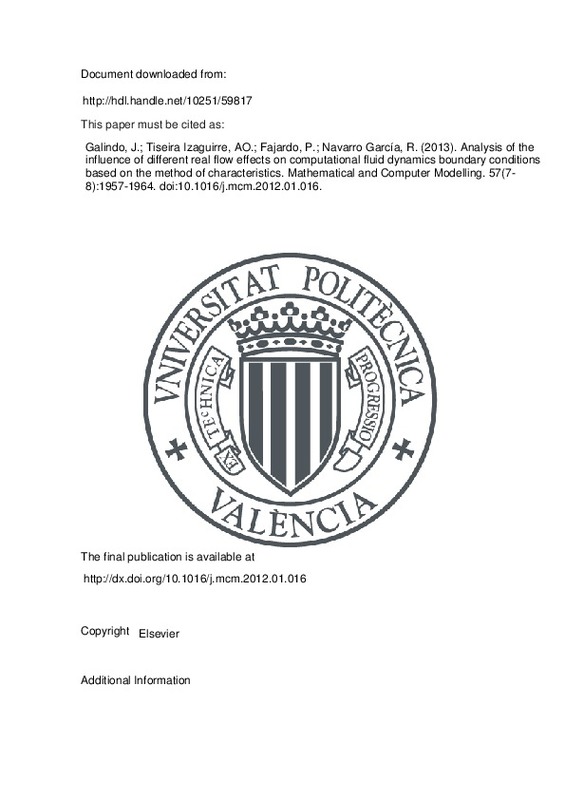JavaScript is disabled for your browser. Some features of this site may not work without it.
Buscar en RiuNet
Listar
Mi cuenta
Estadísticas
Ayuda RiuNet
Admin. UPV
Analysis of the influence of different real flow effects on computational fluid dynamics boundary conditions based on the method of characteristics
Mostrar el registro sencillo del ítem
Ficheros en el ítem
| dc.contributor.author | Galindo, José
|
es_ES |
| dc.contributor.author | Tiseira Izaguirre, Andrés Omar
|
es_ES |
| dc.contributor.author | Fajardo, Pablo
|
es_ES |
| dc.contributor.author | Navarro García, Roberto
|
es_ES |
| dc.date.accessioned | 2016-01-13T12:27:04Z | |
| dc.date.available | 2016-01-13T12:27:04Z | |
| dc.date.issued | 2013-04 | |
| dc.identifier.issn | 0895-7177 | |
| dc.identifier.uri | http://hdl.handle.net/10251/59817 | |
| dc.description.abstract | Nowadays, turbocharged internal combustion engines (ICEs) are very common in automotive powerplants, monopolizing the Diesel sector and having a steadily increasing percentage in the gasoline one. In this frame, the interest in modeling the behavior of the turbomachinery components involved, with the ultimate goal of characterizing the performance of the turbocharged ICE, seems clear. A turbomachine can be simulated using 3D-CFD software, but its computational cost does not allow to reproduce the whole turbocharger test rig. Moreover, the existence of long ducts requires a considerable computational time until the pressure reflections at the boundaries dissipate in order to reach a periodic solution. The use of non-reflecting boundary conditions reduces the needed length of ducts without introducing spurious wave reflections. An anechoic boundary condition (BC) based on the Method of Characteristics has been previously developed, considering the case of an inviscid and adiabatic 1D flow of a perfect gas. However, real flows do not behave in such ideal manner. In this paper, the extension of the scope of the previous BC is sought. In this way, a methodology to evaluate the performance of the anechoic BC under these real flow situations is shown. The consideration of ideal gas instead of perfect gas, the flow viscosity and the non-homentropic flow makes it necessary to modify the Method of Characteristics, since the Riemann Invariants are not constant any more. In this frame they are referred to as Riemann Variables. An additional issue that has been considered is the effect of swirl flow, as the one in the turbine outlet, on the anechoic BC. Some improvements to be implemented in the BC are proposed in order to have a better performance in these real flow situations. | es_ES |
| dc.language | Inglés | es_ES |
| dc.publisher | Elsevier | es_ES |
| dc.relation.ispartof | Mathematical and Computer Modelling | es_ES |
| dc.rights | Reserva de todos los derechos | es_ES |
| dc.subject | CFD simulation | es_ES |
| dc.subject | CFD BC | es_ES |
| dc.subject | Boundary Condition | es_ES |
| dc.subject | Real Effects | es_ES |
| dc.subject | Anechoic BC | es_ES |
| dc.subject | Method of Characteristics | es_ES |
| dc.subject.classification | INGENIERIA AEROESPACIAL | es_ES |
| dc.subject.classification | MAQUINAS Y MOTORES TERMICOS | es_ES |
| dc.title | Analysis of the influence of different real flow effects on computational fluid dynamics boundary conditions based on the method of characteristics | es_ES |
| dc.type | Artículo | es_ES |
| dc.identifier.doi | 10.1016/j.mcm.2012.01.016 | |
| dc.rights.accessRights | Abierto | es_ES |
| dc.contributor.affiliation | Universitat Politècnica de València. Departamento de Máquinas y Motores Térmicos - Departament de Màquines i Motors Tèrmics | es_ES |
| dc.description.bibliographicCitation | Galindo, J.; Tiseira Izaguirre, AO.; Fajardo, P.; Navarro García, R. (2013). Analysis of the influence of different real flow effects on computational fluid dynamics boundary conditions based on the method of characteristics. Mathematical and Computer Modelling. 57(7-8):1957-1964. doi:10.1016/j.mcm.2012.01.016 | es_ES |
| dc.description.accrualMethod | S | es_ES |
| dc.relation.publisherversion | http://dx.doi.org/10.1016/j.mcm.2012.01.016 | es_ES |
| dc.description.upvformatpinicio | 1957 | es_ES |
| dc.description.upvformatpfin | 1964 | es_ES |
| dc.type.version | info:eu-repo/semantics/publishedVersion | es_ES |
| dc.description.volume | 57 | es_ES |
| dc.description.issue | 7-8 | es_ES |
| dc.relation.senia | 233917 | es_ES |







![[Cerrado]](/themes/UPV/images/candado.png)

